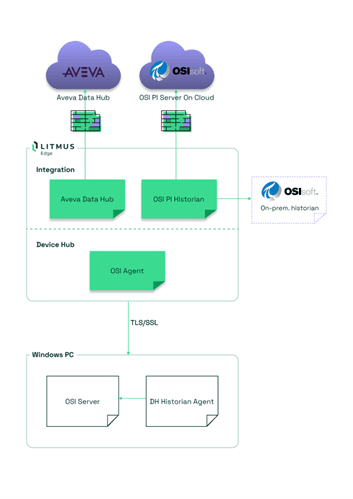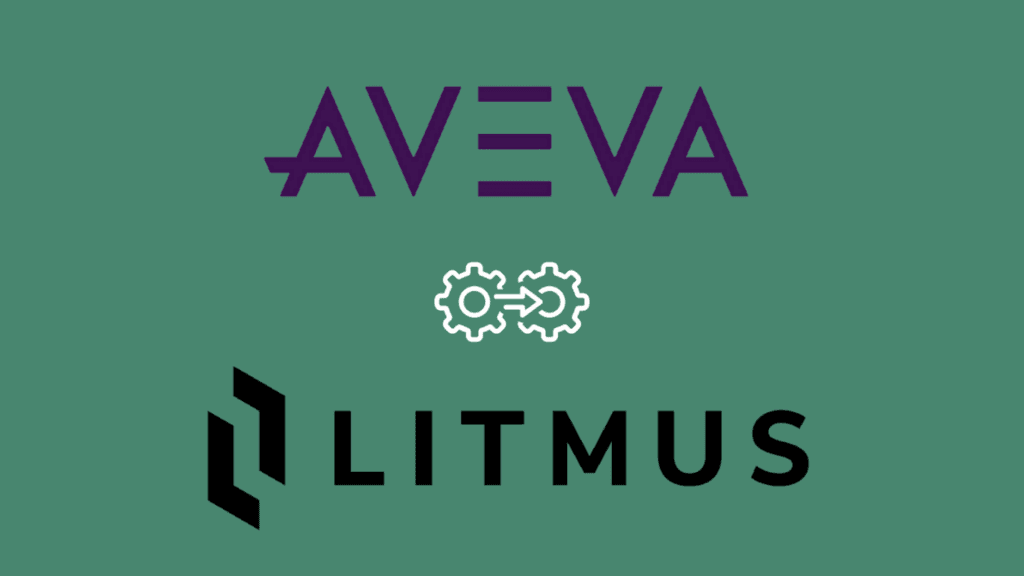Unlock, Activate, and Scale Your Industrial DataOps
We’re in an era of exponential data growth, and industrial enterprises are faced with the same problem. How can we leverage this deluge of data to enhance efficiency and spur innovation?
The integration of Litmus Edge with the AVEVA PI System, formerly known as OSIsoft PI System, is just one way we are addressing this Industrial DataOps challenge.
This article will cover the key benefits and practical applications of integrating Litmus Edge with the AVEVA PI System, enhancing your ability to manage, analyze, and act on industrial data effectively.
If you’re already convinced you need to integrate Litmus Edge with AVEVA PI, please do skip to the end where you can take your next steps. But if you’re just here to learn more, we hope this short article explains why you should join those in the know.
Ok, let’s get down to it!
Overview of AVEVA PI System
So, what is AVEVA PI? Let’s start there. Originally developed by OSIsoft, the AVEVA PI System is a data management solution designed to tackle the unique challenges presented in industrial environments.
It allows for data from various sources to be collected and stored, facilitating rapid insight extraction to optimize business operations.
A stalwart of the manufacturing sector for over four decades, AVEVA PI is focused on data historian functionalities.
What’s the Problem?
What challenges does Litmus Edge integration help AVEVA PI users overcome?
The core issue lies in extracting and leveraging data effectively from the AVEVA PI System. Here are the main hurdles:
Asset Framework SDK: This tool is restricted to Windows due to its reliance on the .NET framework, limiting its adaptability across different platforms.
PI Web API: While it extends data access, it requires an additional purchase, posing a barrier for many facilities.
These constraints limit efficient data utilization, which is crucial for deploying advanced analytics and enhancing operations.
Litmus Edge overcomes these limitations, enhancing your operational agility and intelligence, by providing flexible integration solutions that streamline data access and processing.
 Litmus Edge with AVEVA PI
Litmus Edge with AVEVA PIStrategic Advantages
To effectively navigate the full Industrial DataOps approach with the AVEVA PI System, here at Litmus we follow a three-part strategy: Unlock. Activate. Scale.
Our customers keep telling us that this is how they break down their quest to digitally transform. So, let’s put the integration of Litmus Edge with AVEVA PI—and the substantial benefits it brings — in those terms.
Unlock: Integration Solutions
Litmus Edge provides several integration solutions to unlock your data from the AVEVA PI System, moving past the limitations of the Asset Framework SDK and PI Web API to enhance accessibility:
DH Historian Agent
: This Windows-based agent harnesses the Asset Framework SDK to collect data from the PI historian and securely transmit it to Litmus Edge for further processing.
Northbound Integration
: Using the PI Web API and OMF (Open Messaging Format), this integration enables Litmus Edge to send processed data back to the PI server, simplifying connectivity with proprietary OEM machines.
Cloud Integration
: OSIsoft’s acquisition by Aveva and the introduction of the AVEVA™ Data Hub allow Litmus Edge to send data directly to cloud-based services, enabling remote data management and analysis.
Integrating with Litmus Edge, unlocking all your OT data, takes minutes. Now, the next step is to activate it: to give it context and make it actionable.
That’s where we unleash the power of digital twins.
Activate: Digital Twins
Digital twins enhance the AVEVA PI System by activating your data, providing context, clarity, and usefulness. Creating digital twin models with Litmus Edge, you can use Asset Framework data for superior visualization and deeper analytics.
Transforming raw data into actionable information in this way leads to major operational advancements. Key functionalities include:
Data Enhancement: Digital twins enrich raw data by adding relevant context, crucial for integrating and aligning diverse data sources with your business operations.
Advanced Analytics: By processing contextualized data, users can implement sophisticated analytics for predictive maintenance and process optimization, made possible by Litmus Edge’s capacity for handling complex, real-time computations.
System Integration: Digital twins enhance your enterprise-wide strategies by integrating data across platforms, allowing for easy transfers to cloud services like Azure or Google Cloud.
As we optimize data with digital twins, it’s essential to consider the best ways to manage and this enhanced data and scale up to multiple sites.
That also brings us to a key decision: should we use a historian or cloud-based systems? Let’s delve into these options to determine the most effective data management strategy.
Scale: Data Management Choices
In the scaling phase of Industrial DataOps, the choice between using a historian or adopting cloud-based systems is crucial.
Traditional historians provide robust data access but limit the scope of integration and analysis to local systems. On the other hand, cloud-based solutions enhance scalability and allow for the central management of data from various sources, including remote sites without dedicated servers. They support real-time data processing and enable the use of advanced analytics and AI across the enterprise.
This approach aligns with Industry 4.0 principles, facilitating the deployment of digital twins and custom applications that activate your data, fueling better predictive maintenance and operational efficiency.
Opting for the cloud helps dismantle data silos, promoting a collaborative and insightful operational environment that scales innovations and maximizes digital transformation outcomes across all enterprise levels.
Use Cases
To better appreciate the integration’s advantages, let’s consider a couple of scenarios where Litmus Edge significantly enhances industrial system functionalities and efficiencies.
Condition-Based Monitoring in Manufacturing
Imagine you’re running a manufacturing plant where it’s essential to maintain operational efficiency of critical machinery. Typically, you’d manually check these machines to prevent failures. With Litmus Edge, however, digital twins simulate each machine’s operation in real-time. When a pump reaches a critical operation threshold—say, running for 10,000 hours—Litmus Edge automatically queries the AVEVA PI System for this data.
It then compares the result to pre-set rules, and if the threshold is met, it instantly generates a maintenance work order. This proactive approach minimizes downtime and boosts equipment efficiency by ensuring timely maintenance.
Data Management for Remote Operations
Consider a scenario where your company operates multiple small, remote facilities without the infrastructure for local data processing or an on-site PI server. Managing and analyzing data from these dispersed locations traditionally requires significant engineering resources and complex systems, which can be overwhelming for limited staff. By integrating Litmus Edge, data from various assets across these sites is collected, processed, and securely transmitted to a centralized PI server in your data center.
Unlike using EDS, which often involves cumbersome setup and maintenance, Litmus Edge streamlines connectivity and reduces maintenance demands. This makes an ideal solution for resource-constrained teams.
Expect real-time data analysis, better decision-making capabilities, increased overall efficiency and better responsiveness.
Summary
As you can see, integrating Litmus Edge’s connectivity and real-time processing with AVEVA PI’s data management will revolutionize your approach to Industrial DataOps.
You’ll experience faster decision-making, more efficient workflows, and gain access to advanced tools essential for your success.
What’s more, this integration allows you to get the data you need to fully capitalize on AI/ML capabilities. This will unlock new efficiencies and innovations, maintaining your edge in an increasingly competitive industrial landscape.
Get Started Now
So, are you ready to get started?
If so, the best place to begin is by registering for the DH Historian Agent on the Litmus Central Portal.
Once you’re signed up there, our detailed step-by-step guide will help you on your way.
For more guides like this one, be sure to follow Litmus on LinkedIn, where we regularly publish useful content for digital transformation teams. See you there!



